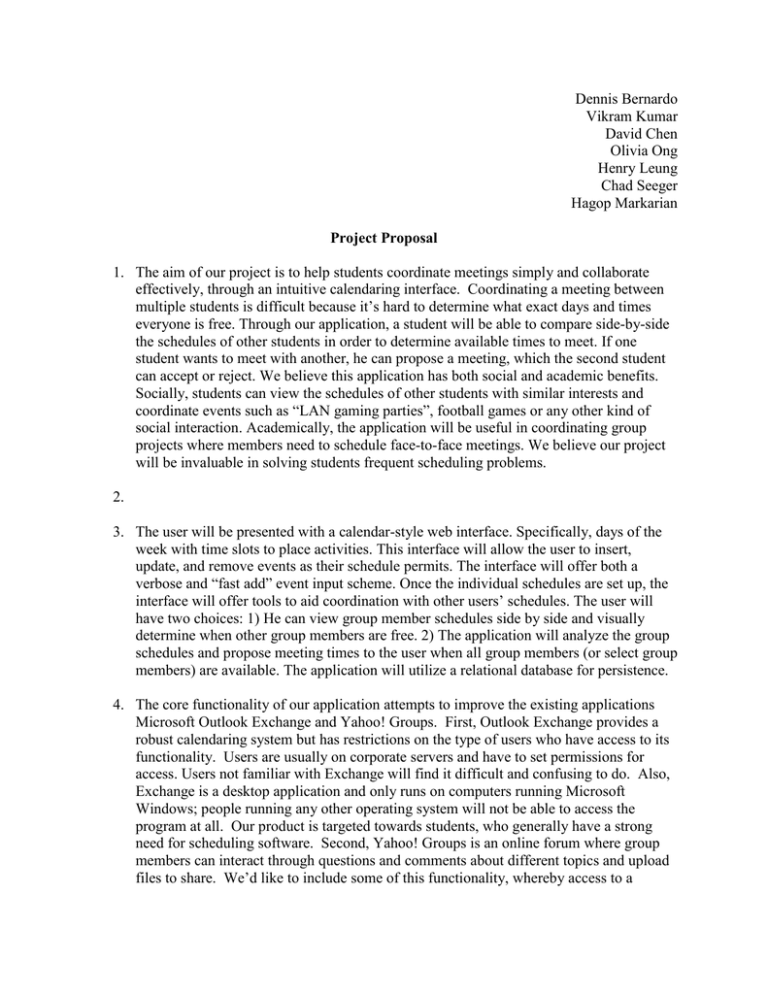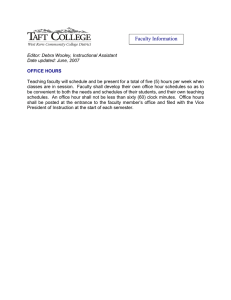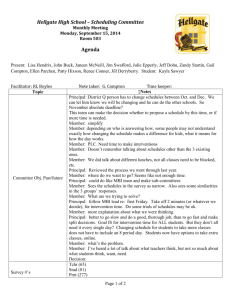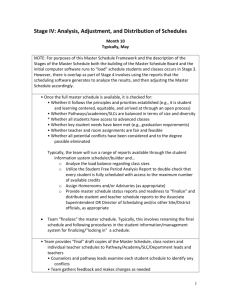Dennis Bernardo Vikram Kumar David Chen Olivia Ong
advertisement

Dennis Bernardo Vikram Kumar David Chen Olivia Ong Henry Leung Chad Seeger Hagop Markarian Project Proposal 1. The aim of our project is to help students coordinate meetings simply and collaborate effectively, through an intuitive calendaring interface. Coordinating a meeting between multiple students is difficult because it’s hard to determine what exact days and times everyone is free. Through our application, a student will be able to compare side-by-side the schedules of other students in order to determine available times to meet. If one student wants to meet with another, he can propose a meeting, which the second student can accept or reject. We believe this application has both social and academic benefits. Socially, students can view the schedules of other students with similar interests and coordinate events such as “LAN gaming parties”, football games or any other kind of social interaction. Academically, the application will be useful in coordinating group projects where members need to schedule face-to-face meetings. We believe our project will be invaluable in solving students frequent scheduling problems. 2. 3. The user will be presented with a calendar-style web interface. Specifically, days of the week with time slots to place activities. This interface will allow the user to insert, update, and remove events as their schedule permits. The interface will offer both a verbose and “fast add” event input scheme. Once the individual schedules are set up, the interface will offer tools to aid coordination with other users’ schedules. The user will have two choices: 1) He can view group member schedules side by side and visually determine when other group members are free. 2) The application will analyze the group schedules and propose meeting times to the user when all group members (or select group members) are available. The application will utilize a relational database for persistence. 4. The core functionality of our application attempts to improve the existing applications Microsoft Outlook Exchange and Yahoo! Groups. First, Outlook Exchange provides a robust calendaring system but has restrictions on the type of users who have access to its functionality. Users are usually on corporate servers and have to set permissions for access. Users not familiar with Exchange will find it difficult and confusing to do. Also, Exchange is a desktop application and only runs on computers running Microsoft Windows; people running any other operating system will not be able to access the program at all. Our product is targeted towards students, who generally have a strong need for scheduling software. Second, Yahoo! Groups is an online forum where group members can interact through questions and comments about different topics and upload files to share. We’d like to include some of this functionality, whereby access to a person’s schedule is restricted to those users with group membership. In addition to schedule sharing, the group will serve as a portal for file sharing and message boards. 5. Our calendaring and scheduling project will be different in the sense that it is a robust calendaring and scheduling solution like Outlook Exchange, yet it is accessible from any web-enabled device. For example, it will be accessible from a desktop computer, laptop or PDA. Also unique to our design is that the focus of the application is not necessarily to organize the schedule of the individual, but to coordinate the schedules of a group of people. Users will have multiple options for coordinating schedules. They can either view schedules side-by-side to get a visual sense of when members are free, or the application will propose times when members are free according to the individual schedules that are in the database. In essence, the project aims to take the calendaring focus of Outlook Exchange and combine it with the group-collaboration focus of Yahoo! Groups in a simple and intuitive way. 6. Initially, we expect college students to be the primary users because students are often required to work in groups. Often, group work tends to be a problem not because of the task or the people involved, but because of the logistics of coordinating schedules and collaborating effectively. The goal of our interface is to remove the logistical problems from the equation and enable students to work in groups effectively. Because computer literacy among students varies greatly between majors, we want to have a balanced interface that is simple and intuitive enough for basic computer users, yet doesn’t seemed “dumbed down” for advanced users. Since almost all college students have a computer and use one, we will assume the typical user will have basic knowledge on how to user a computer and access the internet. Thus, users will range in computer literacy from functional (they can use a web browser but they may not know how to troubleshoot) to professional (they can program their own scheduling system... if they wanted to)--though most will tend toward more literate. Meet John Doe. John is a typical student at San Jose State University. He is a 20-year-old junior who is currently enrolled in two courses, both of which emphasize projects. On top of school, he works 20 hours a week as an intern at a local law firm. He uses his computer for basic tasks- digital imaging, web surfing etc. He tends to dislike working in groups because he has a very busy schedule as do most of the other students at his school. Thus, the logistics of coordinating when to meet is always a problem. What John really wants is a way for his group to easily and effectively be able to coordinate their schedules for both face-to-face meetings and online meetings. 7. Name: Max Shultz Demographics: 23 years old – Mechanical Engineering – Student Contact Info: Name: Stan Sporgis Demographics: 21 years old – EECS – Student Contact Info: Name: Gareth Williams Demographics: 21 years old – IEOR – Student Contact Info: Name: Aziz Joudi Demographics: 21 years old – MCB – Student Contact Info: Name: Miles Timpson Demographics: 20 years old – Economics – Student Contact Info: Name: Amy Wang Demographics: 20 years old – EECS – Student Contact Info: Name: Kendra Wong Demographics: 20 years old – Business – Student Contact Info:


